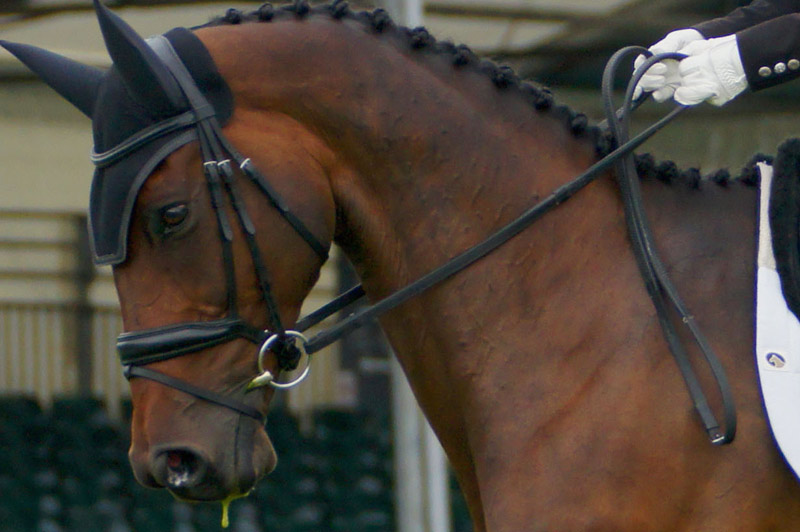Horse’s Nosebands Originally published in Holistic Horse Magazine
by Mary Ann C. Simonds, B.S. M.A.
For most horses, using restrictive devices on their faces is insulting and really not necessary for effective communication. Searching for control, obedience, and connection? These are words used to describe the ultimate goal of training for many equestrians. But what if you are looking for cooperation, communication and a comfortable horse? Would you use the same equipment in training?
As a behavior consultant for over 30 years, I have evaluated thousands of horses and come to the conclusion that bad fitting and/or the misuse of tack is probably the number one reason horses develop problems. What may start as resistance and seems easily treated with a tighter noseband designed to limit the horse’s resistance often turns into physical unsoundness in what I call “compensation syndrome.” Instead of trying to find out why the horse is being disobedient or resistive, tighter nosebands – along with other devices such as draw reins and more severe bits – are often used in hopes of correcting the behavior.
Some of the most common reasons I hear from people using tight nosebands are, in fact, just making the situation worse. A horse who already pulls or opens its mouth is telling you it has a problem and it is the rider’s job to fix the problem, not to clamp the horse’s mouth closed tighter. A horse who grinds its teeth usually has some form of pain in its body, while the horse who leans on the bit is often trying to compensate for bad riding or poor balance. And of course the number one reason why horses, especially mares, do not want to go forward is because their nosebands are too tight. Too many times I have been called out to help a rider get her horse in the ring, only to make the simplest of adjustments by loosening the noseband to allow the horse comfort and watching a relieved horse walk eagerly forward into the arena.
If equestrians ever took an equine biology/ecology course and understood the basic neurobiology of how the horse processes sensory information and muscle engagement, most would question why they are using bits and nosebands instead of hindbrain triggers for training in the first place.

EVOLUTION OF NOSEBANDS
Nosebands evolved for many reasons, but one of the first uses was very practical: to keep the jaws of horses from clattering as they galloped into war laden with heavy armor, while at the same time keeping unruly stallions from taking bites out of each other and affording the often less than experienced soldier some control of his mount.
Modern noseband uses, aside from “looking good” as in the hunter bridle with a loose regular cavesson, or being used to attach a standing martingale, are all designed to limit the horse from opening its mouth and giving the rider more sensitive control over the bit. Fitted correctly, nosebands do just that; but fitted improperly, they can cause pain, limit breathing, and affect structure and movement through the horse’s body, not to mention what it can do to the mental health of the horse who now has restricted communication.

FLAWED SCIENCE
Because nosebands are often required for specific disciplines such as dressage, this “trendy training tool” remains much more popular with people than with horses. A recent study presented at the Equitation Science Conference in October 2011 by Hayley Randle, PhD, may not be helping horses as much as people. Dr. Randle states: “Noseband tightness definitely seems to increase sensitivity to the bit, as it has an effect on rein tension applied to achieve medium contact. This suggests that noseband tightening makes the horse more sensitive to the bit,” she notes. “Essentially, tightening the noseband just one hole appears to reduce the amount of rein tension needed to maintain bit contact.”
Well, of course it does, as the horse is now hypersensitive to any movements in its mouth. Unfortunately, Randle goes on to say, “A better understanding of how noseband tightness affects rein tension could lead to better welfare for the horse, especially as it pertains to conflict behavior.”
What about educating riders more about the horse so they do not have “conflict behaviors” with horses? Horses do not need nosebands to effectively communicate with each other or with humans.
WHY USE A NOSEBAND?
Before using any kind of noseband, ask yourself (and your horse) why you would use a noseband. Would you start off a friendship with a smile and handshake or by taping the person’s lips closed and handcuffing them? If you want to start off a friendly relationship, try giving your horse a chance to “speak” too. Loose nosebands that look pretty are fine to use as long as your horse is not hyper-sensitive, in which case even a light noseband can be irritating.
Horses, like people, are all different, so asking your horse what is most comfortable for communicating is the first step. I have seen some horses love certain bits and hate having any nosebands, while others disliked bits and preferred a noseband.

The goal of any training tack should be to make communication easier between horse and rider, but not at the cost of discomfort to the horse.
Horses are very sensitive social beings and their noses are more sensitive than our finger tips. Horses rely on smell and touch for much of their communication and social bonding, so tying up the nerves in discomfort rather than allowing them to be used the way nature designed them, is often counter-indicative to the goal of training.
So is there ever a reason to use a tight noseband? Rarely. When a horse is a bully, just like a tough kid, tightening the noseband to get the horse to listen to the rider is the lesson – a sort of time-out or listen up. After the horse shows it is listening, the noseband can be loosened.
Thanks to growing awareness that starting off a relationship based on control and pain may not be the easiest path for building a positive partnership between horse and rider, some equestrians are choosing bitless bridles, halters and even no bridles at all as they learn how to communicate with horses using their bodies or off simple touch points on the withers.

Although a noseband might look attractive and be a part of equestrian history, please let’s try to cultivate a more intelligent and compassionate science of communication between horse and rider.
Mary Ann Simonds is an equine ecologist, horse behaviorist and natural health consultant. She is the originator of Enlightened Horsemanship(tm) and Enchanted Riding(tm). She can be reached at [email protected] or by visiting www.maryannsimonds.com

